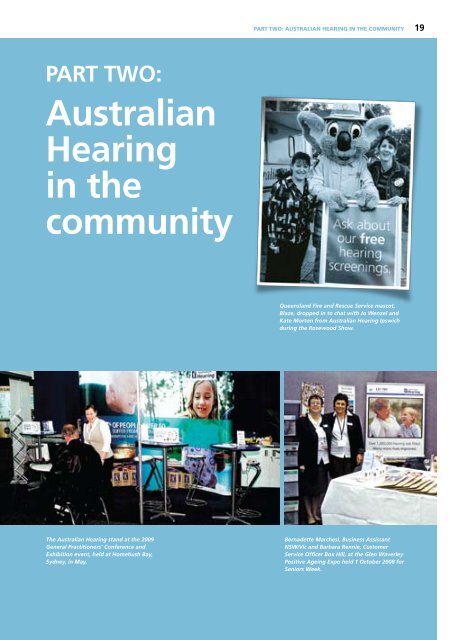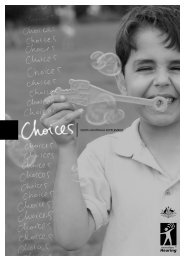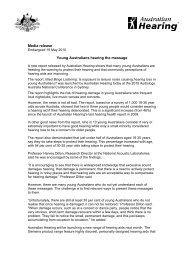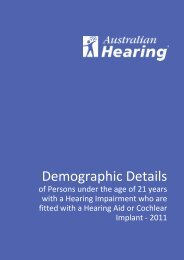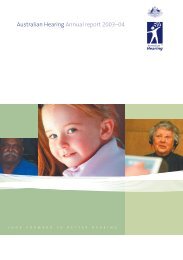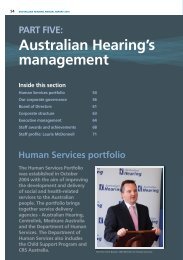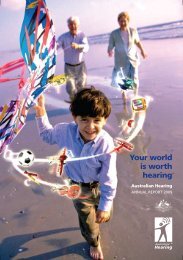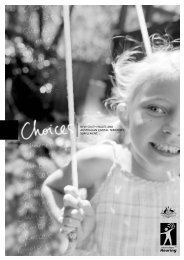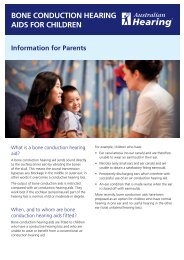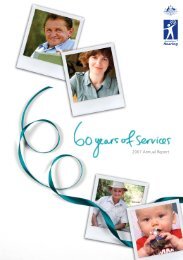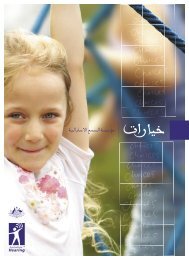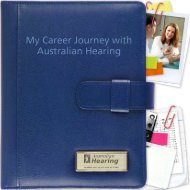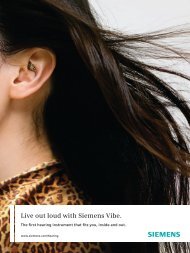Part Two: Australian Hearing in the community
Part Two: Australian Hearing in the community
Part Two: Australian Hearing in the community
You also want an ePaper? Increase the reach of your titles
YUMPU automatically turns print PDFs into web optimized ePapers that Google loves.
<strong>Part</strong> <strong>Two</strong>: <strong>Australian</strong> <strong>Hear<strong>in</strong>g</strong> <strong>in</strong> <strong>the</strong> <strong>community</strong><br />
19<br />
<strong>Part</strong> <strong>Two</strong>:<br />
<strong>Australian</strong><br />
<strong>Hear<strong>in</strong>g</strong><br />
<strong>in</strong> <strong>the</strong><br />
<strong>community</strong><br />
Queensland Fire and Rescue Service mascot,<br />
Blaze, dropped <strong>in</strong> to chat with Jo Wenzel and<br />
Kate Morton from <strong>Australian</strong> <strong>Hear<strong>in</strong>g</strong> Ipswich<br />
dur<strong>in</strong>g <strong>the</strong> Rosewood Show.<br />
The <strong>Australian</strong> <strong>Hear<strong>in</strong>g</strong> stand at <strong>the</strong> 2009<br />
General Practitioners’ Conference and<br />
Exhibition event, held at Homebush Bay,<br />
Sydney, <strong>in</strong> May.<br />
Bernadette Marchesi, Bus<strong>in</strong>ess Assistant<br />
NSW/Vic and Barbara Rennie, Customer<br />
Service Officer Box Hill, at <strong>the</strong> Glen Waverley<br />
Positive Age<strong>in</strong>g Expo held 1 October 2008 for<br />
Seniors Week.
20 <strong>Australian</strong> <strong>Hear<strong>in</strong>g</strong> Annual report 2009
<strong>Part</strong> <strong>Two</strong>: <strong>Australian</strong> <strong>Hear<strong>in</strong>g</strong> <strong>in</strong> <strong>the</strong> <strong>community</strong><br />
21<br />
Danielle Richardson, 16<br />
Paediatric client, <strong>Australian</strong> <strong>Hear<strong>in</strong>g</strong> Southport<br />
Danielle, 16 years,<br />
is a full-time ballet<br />
student. Her goal<br />
is to make it <strong>in</strong>to<br />
<strong>the</strong> Royal Ballet <strong>in</strong><br />
London. She shares<br />
with us her passion<br />
for dance and how<br />
she manages her<br />
hear<strong>in</strong>g loss.<br />
‘I have been danc<strong>in</strong>g s<strong>in</strong>ce I<br />
was five. I started to love it<br />
and I really wanted to keep on<br />
do<strong>in</strong>g it. Most of my friends<br />
backed out but I kept go<strong>in</strong>g.<br />
I want to get <strong>in</strong>to <strong>the</strong> Royal<br />
Ballet, which is <strong>the</strong> hardest<br />
to get <strong>in</strong>to – that’s my goal.<br />
It’s <strong>in</strong> London. I’m go<strong>in</strong>g to<br />
try out <strong>in</strong> a couple of years.<br />
‘I dance about 40 hours a week.<br />
I go to school once a week on<br />
Monday and I br<strong>in</strong>g my school<br />
work to <strong>the</strong> studio. All <strong>the</strong><br />
girls here do that. Some do<br />
school by correspondence.<br />
‘My mum first realised I had<br />
a hear<strong>in</strong>g loss when I was<br />
three. When I was a baby, I’d<br />
sleep through anyth<strong>in</strong>g – <strong>the</strong><br />
vacuum cleaner, music. I have<br />
hear<strong>in</strong>g loss <strong>in</strong> both ears. I wear<br />
<strong>in</strong>-<strong>the</strong>-ear aids so that I can<br />
dance and <strong>the</strong>y won’t fall out.<br />
I was go<strong>in</strong>g to get <strong>the</strong> ones<br />
that go completely <strong>in</strong> <strong>the</strong> ear,<br />
but my ear canal is too small.<br />
‘My friends talk to me <strong>the</strong><br />
same as any o<strong>the</strong>r person. I<br />
can lip read. One time I had on<br />
an FM [frequency modulation<br />
system] and one of my teachers<br />
was wear<strong>in</strong>g it and he went<br />
to <strong>the</strong> phone and I could hear<br />
everyth<strong>in</strong>g he was say<strong>in</strong>g and<br />
everyth<strong>in</strong>g <strong>the</strong> o<strong>the</strong>r lady was<br />
say<strong>in</strong>g. Kids would come up<br />
and be like, “What’s beh<strong>in</strong>d<br />
your ear?” Mum would come<br />
to school and get <strong>the</strong> teacher<br />
to talk about FMs and hear<strong>in</strong>g<br />
aids and let <strong>the</strong>m have a go of<br />
it. I used to feel special, because<br />
I was like, “I’ve got this…” and<br />
my friends were like, “Ooh,<br />
I want hear<strong>in</strong>g aids now!”<br />
‘We tried us<strong>in</strong>g FMs here [at <strong>the</strong><br />
dance school]. The teacher wore<br />
it down too low and all I could<br />
hear was her walk<strong>in</strong>g. I was<br />
like, “Just switch it off.” I’m f<strong>in</strong>e<br />
with hear<strong>in</strong>g <strong>the</strong> music. When<br />
I have trouble, I just ask <strong>the</strong>m<br />
to turn it up and <strong>the</strong>n I’m f<strong>in</strong>e.<br />
‘I have been go<strong>in</strong>g to <strong>the</strong><br />
same centre [Southport]<br />
<strong>the</strong> whole time. Lynda is my<br />
audiologist. The staff at <strong>the</strong><br />
centre have been great.<br />
‘Danc<strong>in</strong>g is what I’m focused<br />
on, it’s my biggest passion.<br />
My favourite dancer is Darcey<br />
Bussell. She’s <strong>in</strong> <strong>the</strong> Royal Ballet<br />
and she’s got really good feet.<br />
I was part-time last year – 30<br />
hours per week. Now I am fulltime<br />
with two o<strong>the</strong>rs. This is<br />
one of <strong>the</strong> best schools on <strong>the</strong><br />
coast. I’ve gotten this far and I<br />
am go<strong>in</strong>g to keep on go<strong>in</strong>g.’<br />
“Danc<strong>in</strong>g is what I’m focused<br />
on, it’s my biggest passion.<br />
My favourite dancer is Darcey<br />
Bussell. She’s <strong>in</strong> <strong>the</strong> Royal Ballet<br />
and she’s got really good feet.”
22 <strong>Australian</strong> <strong>Hear<strong>in</strong>g</strong> Annual report 2009<br />
Our Community<br />
Service Obligation<br />
program<br />
We receive fixed fund<strong>in</strong>g annually<br />
to deliver services designated as<br />
Community Service Obligation (CSO)<br />
under a Memorandum of Understand<strong>in</strong>g<br />
with <strong>the</strong> Department of Health and<br />
Age<strong>in</strong>g’s Office of <strong>Hear<strong>in</strong>g</strong> Services<br />
(OHS). Approximately 25 per cent of<br />
our core bus<strong>in</strong>ess is designated as CSO.<br />
Services for babies,<br />
children and young<br />
people up to 21<br />
In <strong>the</strong> 2008 calendar year, we<br />
fitted 1,852 children with <strong>the</strong>ir<br />
first hear<strong>in</strong>g aids. There were<br />
201 babies (10.9 per cent)<br />
fitted who were born <strong>in</strong> 2008,<br />
<strong>the</strong> largest proportion of new<br />
fitt<strong>in</strong>gs by birth year, reflect<strong>in</strong>g<br />
<strong>the</strong> impact of newborn hear<strong>in</strong>g<br />
screen<strong>in</strong>gs around <strong>the</strong> country.<br />
Dur<strong>in</strong>g 2008/09, we provided<br />
56,358 services and 14,605<br />
hear<strong>in</strong>g devices, <strong>in</strong>clud<strong>in</strong>g hear<strong>in</strong>g<br />
aids and FM systems, to children<br />
and young people under 21.<br />
This represents a small <strong>in</strong>crease<br />
(0.4 per cent) <strong>in</strong> <strong>the</strong> number of<br />
services provided and a six per<br />
cent reduction <strong>in</strong> <strong>the</strong> number of<br />
devices fitted s<strong>in</strong>ce 2007/08. The<br />
ma<strong>in</strong> reason for this change was<br />
an 18.5 per cent reduction <strong>in</strong><br />
<strong>the</strong> number of FM devices fitted,<br />
as a consequence of <strong>the</strong> FM<br />
upgrade program completion.<br />
At 30 June 2009, we had 14,887<br />
children with hear<strong>in</strong>g aids and<br />
cochlear implants – an <strong>in</strong>crease<br />
of six per cent compared to June<br />
2008. More than 1,600 children<br />
are cochlear implant users.<br />
This year, we conducted a survey<br />
of parents whose children were<br />
aged less than 12 years, to<br />
<strong>in</strong>vestigate children’s hear<strong>in</strong>g aid<br />
use and satisfaction with <strong>the</strong>ir aid<br />
and our service provision. Results<br />
were pleas<strong>in</strong>g, with 93 per cent of<br />
<strong>the</strong> 2,705 respondents <strong>in</strong>dicat<strong>in</strong>g<br />
<strong>the</strong>y were satisfied or very satisfied<br />
with overall service provision. A<br />
fur<strong>the</strong>r 89 per cent of respondents<br />
were satisfied or very satisfied<br />
with <strong>the</strong>ir child’s hear<strong>in</strong>g aids.<br />
A new cl<strong>in</strong>ical equipment contract<br />
enabled us to improve <strong>the</strong> ease of<br />
Otoacoustic emission (OAE) test<strong>in</strong>g<br />
for children via <strong>the</strong> <strong>in</strong>troduction<br />
of portable OAE screeners.<br />
Otoacoustic emission test<strong>in</strong>g<br />
confirms both <strong>the</strong> existence of a<br />
hear<strong>in</strong>g loss and helps determ<strong>in</strong>e<br />
which part of <strong>the</strong> hear<strong>in</strong>g pathway<br />
has been affected. These tests<br />
form an important part of <strong>the</strong><br />
hear<strong>in</strong>g assessment series of tests.<br />
FM technology<br />
FM systems provide hear<strong>in</strong>g<br />
aid users with improved ability<br />
to hear a teacher or parent<br />
over distance or <strong>in</strong> noisy or<br />
reverberant conditions. This<br />
occurs by transmitt<strong>in</strong>g <strong>the</strong> signal<br />
from <strong>the</strong> microphone wearer<br />
directly <strong>in</strong>to a receiver worn with<br />
hear<strong>in</strong>g aids just like a personal<br />
one-to-one radio station.<br />
This year, we conducted a survey of parents whose children<br />
were aged less than 12 years, to <strong>in</strong>vestigate children’s hear<strong>in</strong>g<br />
aid use and satisfaction with <strong>the</strong>ir aid and our service provision.<br />
Results were pleas<strong>in</strong>g, with 93 per cent of <strong>the</strong> 2,705 respondents<br />
<strong>in</strong>dicat<strong>in</strong>g <strong>the</strong>y were satisfied or very satisfied with overall<br />
service provision. A fur<strong>the</strong>r 89 per cent of respondents were<br />
satisfied or very satisfied with <strong>the</strong>ir child’s hear<strong>in</strong>g aids.
<strong>Part</strong> <strong>Two</strong>: <strong>Australian</strong> <strong>Hear<strong>in</strong>g</strong> <strong>in</strong> <strong>the</strong> <strong>community</strong><br />
23<br />
We updated our FM range <strong>in</strong><br />
March 2009 as <strong>the</strong> result of a new<br />
supply contract for FM systems.<br />
The new range offers improved<br />
ease of use and troubleshoot<strong>in</strong>g<br />
for students, parents and teachers.<br />
In 2008/09, we completed a<br />
two-year program that enabled<br />
children to upgrade from bodyworn<br />
FM receiver technology to<br />
more discreet and easy-to-manage<br />
ear level technology. A total<br />
of 1,655 ear level FM receivers<br />
were fitted to aided children <strong>in</strong><br />
2008/09, which comprises both<br />
upgrades and new fitt<strong>in</strong>gs.<br />
<strong>Hear<strong>in</strong>g</strong> devices for<br />
babies, children and<br />
young people up to 21<br />
We added two new hear<strong>in</strong>g aids<br />
to <strong>the</strong> fully subsidised paediatric<br />
range, enhanc<strong>in</strong>g our ability to<br />
meet <strong>the</strong> needs of children with<br />
severe to profound hear<strong>in</strong>g loss<br />
and those who wish to use <strong>the</strong>ir<br />
hear<strong>in</strong>g aids with technology such<br />
as mobile phones and computers.<br />
We updated our paediatric<br />
hear<strong>in</strong>g aid fitt<strong>in</strong>g protocols <strong>in</strong><br />
light of research from NAL and<br />
our hear<strong>in</strong>g aid provider, Siemens,<br />
which <strong>in</strong>dicated that children<br />
of all ages have <strong>the</strong> potential to<br />
benefit from <strong>the</strong> use of directional<br />
microphone technology. Prior to<br />
this research f<strong>in</strong>d<strong>in</strong>g, directional<br />
microphones were traditionally<br />
used with children of late<br />
primary school age or older.<br />
In addition to support<strong>in</strong>g repairs<br />
and ma<strong>in</strong>tenance for cochlear<br />
implant speech processors, we are<br />
also funded to provide paediatric<br />
cochlear implantees with upgraded<br />
speech processor technology. This<br />
year, we provided 269 children<br />
with new cochlear implant speech<br />
processors through our speech<br />
processor upgrade program.<br />
We fitted <strong>the</strong> majority of <strong>the</strong>se<br />
children with <strong>the</strong> Freedom for<br />
Nucleus 22 speech processor,<br />
which was released <strong>in</strong> 2008.<br />
Cl<strong>in</strong>ical protocols for<br />
Indigenous children<br />
<strong>Hear<strong>in</strong>g</strong> assessments conducted<br />
<strong>in</strong> remote sites face a number of<br />
limitations, as test environments<br />
are not purpose-designed for<br />
audiometric assessment. However,<br />
while it has been possible to<br />
obta<strong>in</strong> at least some results on<br />
older children and adults under<br />
<strong>the</strong>se conditions, it was not<br />
possible to assess children aged<br />
less than three due to <strong>the</strong> lack of<br />
an appropriate reward system.<br />
In 2008/09, we completed a<br />
field trial that <strong>in</strong>volved us<strong>in</strong>g<br />
a portable DVD player with<br />
customised reward to perform<br />
Visual Re<strong>in</strong>forcement Orientation<br />
Audiometry for children aged<br />
from seven months to three years.<br />
We successfully conducted trials<br />
at six remote sites <strong>in</strong> Central and<br />
Western Australia. This technique<br />
allows us to provide <strong>in</strong>fants and<br />
toddlers with a level of assessment<br />
that is equivalent to that offered<br />
to older clients. As a result, many<br />
families will be spared <strong>the</strong> time<br />
and expense of travell<strong>in</strong>g to urban<br />
or regional centres <strong>in</strong> order to<br />
have <strong>the</strong>ir babies’ hear<strong>in</strong>g tested.<br />
Adults with<br />
complex hear<strong>in</strong>g<br />
rehabilitation needs<br />
Adults eligible under <strong>the</strong> Voucher<br />
program who have a severe to<br />
profound hear<strong>in</strong>g loss or severe<br />
communication impairment are<br />
designated as CSO. We ma<strong>in</strong>ta<strong>in</strong>ed<br />
our reputation as be<strong>in</strong>g <strong>the</strong> leader<br />
<strong>in</strong> assessment and rehabilitation<br />
by cont<strong>in</strong>ually review<strong>in</strong>g our<br />
cl<strong>in</strong>ical practice and products for<br />
adults with complex needs.<br />
Dur<strong>in</strong>g 2008/09, client numbers<br />
grew by 2,123 and at 30 June<br />
2009, we had 19,415 CSO<br />
adult clients, an <strong>in</strong>crease of<br />
12.3 per cent from 2007/08.<br />
Access to high levels<br />
of technology<br />
In 2008/09, we provided 1,484<br />
more CSO hours for adults with<br />
complex needs compared with<br />
<strong>the</strong> same period last year (a five<br />
per cent <strong>in</strong>crease). The number of<br />
devices fitted to adults with complex<br />
needs <strong>in</strong>creased by 1,865; 14.6<br />
per cent higher than <strong>in</strong> 2007/08.<br />
We cont<strong>in</strong>ued to review <strong>the</strong><br />
level of technology provided<br />
to adults with complex needs<br />
and this year added <strong>the</strong> Phonak<br />
Naida V to <strong>the</strong> range offered.<br />
The Phonak Naida V hear<strong>in</strong>g aid<br />
offers ‘SoundRecover’, a feature
24 <strong>Australian</strong> <strong>Hear<strong>in</strong>g</strong> Annual report 2009<br />
Our Community Service Obligation<br />
program (cont<strong>in</strong>ued)<br />
which aims to improve audibility of<br />
high frequency speech sounds for<br />
clients who are unable to detect<br />
or use high frequency speech<br />
<strong>in</strong>formation via a conventional<br />
hear<strong>in</strong>g aid. We are collect<strong>in</strong>g<br />
data on those clients who are<br />
fitted with this technology to<br />
evaluate <strong>the</strong> outcomes, but <strong>in</strong>itial<br />
<strong>in</strong>dications have been positive for<br />
those clients whose hear<strong>in</strong>g loss<br />
<strong>in</strong>dicates a need for this feature.<br />
We cont<strong>in</strong>ued to upgrade o<strong>the</strong>r<br />
clients to <strong>the</strong> mid-range technology<br />
hear<strong>in</strong>g aids, such as <strong>the</strong> Siemens<br />
Cielo 2, as a m<strong>in</strong>imum standard.<br />
These aids have features such as<br />
greater speech enhancement and<br />
noise reduction and automatic<br />
adaptive directional microphones.<br />
Adults with complex needs<br />
who have appropriate listen<strong>in</strong>g<br />
goals were also fitted with<br />
new FM systems, enabl<strong>in</strong>g<br />
<strong>the</strong>m to hear across greater<br />
distances and cope better with<br />
compet<strong>in</strong>g background noise.<br />
Evaluation of service<br />
delivery to provide <strong>the</strong><br />
best hear<strong>in</strong>g care<br />
In 2008, we surveyed adult clients<br />
who have severe communication<br />
impairment, as part of our<br />
commitment to regularly evaluate<br />
outcomes for CSO adult clients.<br />
This survey was identical to that of<br />
a previous survey <strong>in</strong> 2006 of adult<br />
clients with severe and profound<br />
hear<strong>in</strong>g losses. Responses to<br />
<strong>the</strong> 2008 survey <strong>in</strong>dicated that<br />
<strong>the</strong>se clients report equally high<br />
levels of service satisfaction as<br />
those previously surveyed. They<br />
also reported a greater degree<br />
of perceived benefit from <strong>the</strong>ir<br />
devices across all listen<strong>in</strong>g<br />
situations, compared to <strong>the</strong><br />
previously surveyed adults who had<br />
greater degrees of hear<strong>in</strong>g loss.<br />
As some of <strong>the</strong> clients surveyed<br />
have additional physical or visual<br />
disabilities which impact not only<br />
on <strong>the</strong>ir communication, but also<br />
on <strong>the</strong>ir ability to manage <strong>the</strong>ir<br />
hear<strong>in</strong>g aids, it is understandable<br />
that aid management issues<br />
were reported more frequently<br />
than by <strong>the</strong> group with severe<br />
and profound hear<strong>in</strong>g losses.<br />
We also collected and analysed<br />
International Outcomes Inventory<br />
– <strong>Hear<strong>in</strong>g</strong> Aids data <strong>in</strong> this survey.<br />
The clients surveyed <strong>in</strong> 2008, who<br />
have lesser degrees of hear<strong>in</strong>g<br />
loss, reported us<strong>in</strong>g <strong>the</strong>ir devices<br />
less than those with severe and<br />
profound hear<strong>in</strong>g losses <strong>in</strong> 2006.<br />
The scores on <strong>the</strong> two surveys<br />
were very similar <strong>in</strong> all o<strong>the</strong>r<br />
measures. See Graph <strong>Two</strong> below.<br />
Graph <strong>Two</strong>: International Outcomes Inventory – <strong>Hear<strong>in</strong>g</strong> Aids (IOI-HA) – Mean Scores<br />
Comparison with USA, CSO Adult 2006 (=>80dB) and CSO Adult 2008 (
<strong>Part</strong> <strong>Two</strong>: <strong>Australian</strong> <strong>Hear<strong>in</strong>g</strong> <strong>in</strong> <strong>the</strong> <strong>community</strong><br />
25<br />
May Howard, client<br />
<strong>Australian</strong> <strong>Hear<strong>in</strong>g</strong> Perth<br />
Turn<strong>in</strong>g 105 on 1 July 2009,<br />
and celebrat<strong>in</strong>g her birthday<br />
with <strong>the</strong> local <strong>community</strong> and<br />
close family, May Howard is<br />
one of our oldest clients. May<br />
grew up on <strong>the</strong> Beagle Bay<br />
Mission, north of Broome,<br />
run by <strong>the</strong> Catholic Church.<br />
It was <strong>the</strong>re that she met her<br />
husband and raised her family.<br />
Her son, Jimmy Howard, is a<br />
country s<strong>in</strong>ger well known<br />
around <strong>the</strong> Broome area.<br />
Peter Howard, May’s second<br />
son, runs his own tourist<br />
bus<strong>in</strong>ess outside of Broome.<br />
May has many grandchildren<br />
and great grandchildren and<br />
lives with her great niece Jo,<br />
who is her carer. One of May’s<br />
grandchildren, Sel<strong>in</strong>a, is also<br />
a health worker at Broome<br />
Aborig<strong>in</strong>al Medical Service.<br />
May first noticed problems<br />
hear<strong>in</strong>g o<strong>the</strong>r people <strong>in</strong> <strong>the</strong><br />
May Howard with audiologist Sally Regan, at <strong>the</strong> Broome Aborig<strong>in</strong>al Medical Service.<br />
1980s. She had particular<br />
trouble hear<strong>in</strong>g her family<br />
and when shopp<strong>in</strong>g. May has<br />
a severe to profound hear<strong>in</strong>g<br />
loss, but prefers to use one<br />
aid. S<strong>in</strong>ce us<strong>in</strong>g her Cielo 2P<br />
aid, she is able to better hear<br />
and converse with her family.<br />
We see May at <strong>the</strong> Broome<br />
AHSPIA site, where we work<br />
closely with <strong>the</strong> staff of Broome<br />
Aborig<strong>in</strong>al Medical Service<br />
to provide hear<strong>in</strong>g services<br />
<strong>in</strong> <strong>the</strong> local <strong>community</strong>.<br />
L–R Jade Frederiksen (AHSPIA Audiologist), Nikkita Yunup<strong>in</strong>gu,<br />
Aileen Andrews and Maryanne Arrieta (Aborig<strong>in</strong>al Health Worker<br />
/Community Audiometrist) from Darw<strong>in</strong> at Ngukurr Community<br />
Education Centre, Roper River <strong>in</strong> <strong>the</strong> Nor<strong>the</strong>rn Territory.<br />
The girls are wear<strong>in</strong>g <strong>the</strong>ir<br />
new ‘<strong>Hear<strong>in</strong>g</strong> Hats’ which are<br />
fitted with bone conductor<br />
hear<strong>in</strong>g aids. AHSPIA<br />
audiologists visit<strong>in</strong>g remote<br />
Indigenous communities issue<br />
a large number of hear<strong>in</strong>g<br />
hats to assist children with<br />
conductive hear<strong>in</strong>g loss,<br />
particularly to hear <strong>in</strong> class.<br />
These students are supported<br />
by <strong>the</strong> Special Education<br />
teachers and classroom<br />
teachers, who work <strong>in</strong><br />
conjunction with<br />
our audiologists.
26 <strong>Australian</strong> <strong>Hear<strong>in</strong>g</strong> Annual report 2009
<strong>Part</strong> <strong>Two</strong>: <strong>Australian</strong> <strong>Hear<strong>in</strong>g</strong> <strong>in</strong> <strong>the</strong> <strong>community</strong><br />
27<br />
Visit<strong>in</strong>g Docker River<br />
Case Study<br />
In <strong>the</strong> mid morn<strong>in</strong>g 35 degree<br />
heat, audiologists Rebecca<br />
Allnut and Alison K<strong>in</strong>g from<br />
<strong>Australian</strong> <strong>Hear<strong>in</strong>g</strong> and Renee<br />
Garuccio from NT <strong>Hear<strong>in</strong>g</strong>,<br />
pushed open <strong>the</strong> door to <strong>the</strong><br />
Docker River Cl<strong>in</strong>ic <strong>in</strong> March<br />
this year. The cl<strong>in</strong>icians were<br />
on one of three annual visits<br />
to Docker River, an Indigenous<br />
<strong>community</strong> of approximately<br />
300 to 350 people. Docker<br />
River is a two-and-a-half hour<br />
trip by 4WD from <strong>the</strong> Olgas,<br />
located a few kilometres from<br />
<strong>the</strong> Western Australia border.<br />
Docker River is a traditional<br />
Indigenous <strong>community</strong>, and<br />
for most people, English is<br />
a third or fourth language.<br />
This poses challenges for <strong>the</strong><br />
education of our paediatric<br />
clients, primarily taught <strong>in</strong><br />
English, which are exacerbated<br />
by hear<strong>in</strong>g problems caused<br />
by Otitis media (middle ear<br />
<strong>in</strong>fection). Known locally as<br />
<strong>the</strong> ‘Ear Mob’, our staff br<strong>in</strong>g<br />
hear<strong>in</strong>g health messages <strong>in</strong>to<br />
communities that are already<br />
deal<strong>in</strong>g with a number of<br />
complex health issues.<br />
Rebecca Allnut has visited<br />
<strong>the</strong> Docker River <strong>community</strong><br />
for n<strong>in</strong>e years. Our trips are<br />
often done <strong>in</strong> collaboration<br />
with NT <strong>Hear<strong>in</strong>g</strong>. This ensures<br />
a smooth transition between<br />
<strong>the</strong> detection and diagnosis<br />
of hear<strong>in</strong>g loss by NT <strong>Hear<strong>in</strong>g</strong><br />
and <strong>the</strong> provision of hear<strong>in</strong>g<br />
devices and follow-up services<br />
by <strong>Australian</strong> <strong>Hear<strong>in</strong>g</strong>.<br />
Dur<strong>in</strong>g this visit, Rebecca<br />
and Alison met with school<br />
teachers to discuss results of<br />
students’ hear<strong>in</strong>g assessments<br />
and hear<strong>in</strong>g aid fitt<strong>in</strong>gs. They<br />
were also able to help <strong>the</strong><br />
teachers <strong>in</strong>vestigate classroom<br />
amplification options and<br />
fund<strong>in</strong>g sources, and provide<br />
<strong>the</strong>m with <strong>in</strong>formation about<br />
<strong>the</strong> impact of hear<strong>in</strong>g loss on<br />
educational performance for<br />
children who are learn<strong>in</strong>g <strong>in</strong><br />
a second language. Rebecca<br />
and Alison also spent time<br />
updat<strong>in</strong>g new cl<strong>in</strong>ic staff<br />
about our services, and by<br />
<strong>the</strong> end, had organised two<br />
<strong>community</strong> education events<br />
for May 2009 and a talk at<br />
<strong>the</strong> local primary school.<br />
Over her n<strong>in</strong>e years, Rebecca<br />
has met many people <strong>in</strong> several<br />
different communities. Good<br />
communication between<br />
health workers, audiologists<br />
and educators is essential <strong>in</strong><br />
ensur<strong>in</strong>g that clients do not slip<br />
through <strong>the</strong> net as <strong>the</strong>y move<br />
between communities. Rebecca<br />
is now well known and our<br />
clients are happy to talk to her,<br />
as well as ask her for advice.<br />
This trip was also used to<br />
trial some new <strong>in</strong>fant test<strong>in</strong>g<br />
equipment, which will allow us<br />
to test babies’ hear<strong>in</strong>g onsite<br />
ra<strong>the</strong>r than fly<strong>in</strong>g <strong>the</strong>m to<br />
Alice Spr<strong>in</strong>gs. Parents were<br />
delighted with <strong>the</strong>ir babies’<br />
responses to <strong>the</strong> hear<strong>in</strong>g<br />
test, sett<strong>in</strong>g <strong>the</strong> scene for a<br />
positive discussion about <strong>the</strong><br />
importance of hear<strong>in</strong>g.<br />
Audiologists who visit remote<br />
communities need to be<br />
highly skilled <strong>in</strong> otoscopy. In<br />
<strong>the</strong> course of <strong>the</strong> week, our<br />
audiologists encountered<br />
every possible variation on a<br />
perforated ear drum, as well<br />
as test results which didn’t<br />
follow <strong>the</strong> typical patterns.<br />
However, it was reward<strong>in</strong>g to<br />
see <strong>the</strong> improvements result<strong>in</strong>g<br />
from successful ear surgery or<br />
a new hear<strong>in</strong>g aid fitt<strong>in</strong>g.<br />
The challenges of deliver<strong>in</strong>g<br />
an audiology program <strong>in</strong> a<br />
remote location are certa<strong>in</strong>ly<br />
great, but <strong>the</strong> relationships<br />
formed and <strong>the</strong> opportunity to<br />
make a positive contribution to<br />
<strong>the</strong> health of <strong>the</strong> <strong>community</strong><br />
are <strong>the</strong>ir own reward.<br />
“The challenges of deliver<strong>in</strong>g an audiology program<br />
<strong>in</strong> a remote location are certa<strong>in</strong>ly great, but <strong>the</strong><br />
relationships we form and <strong>the</strong> opportunity to make<br />
a positive contribution to <strong>the</strong> health of <strong>the</strong><br />
<strong>community</strong> are <strong>the</strong>ir own reward.”
28 <strong>Australian</strong> <strong>Hear<strong>in</strong>g</strong> Annual report 2009<br />
Indigenous Services<br />
work<strong>in</strong>g toge<strong>the</strong>r<br />
Many Aborig<strong>in</strong>al and Torres<br />
Strait Islander peoples experience<br />
hear<strong>in</strong>g health problems typical<br />
of third world communities. Up<br />
to seven <strong>in</strong> 10 Indigenous adults<br />
experience hear<strong>in</strong>g loss.<br />
The majority of Aborig<strong>in</strong>al babies<br />
<strong>in</strong> remote communities will have<br />
symptoms of ear disease by<br />
<strong>the</strong> time <strong>the</strong>y are three months<br />
old. By <strong>the</strong> time an Indigenous<br />
child reaches <strong>the</strong> age of 14,<br />
<strong>the</strong>y are likely to have spent 32<br />
months with ear disease and<br />
hear<strong>in</strong>g loss. This compares with<br />
an average of three months<br />
for a non-Indigenous child.<br />
Ear disease can affect speech and<br />
language development, enjoyment<br />
of school, form<strong>in</strong>g of friendships,<br />
educational achievement<br />
and vocational choices.<br />
Our Indigenous<br />
Services program<br />
Our Indigenous Services program<br />
commenced more than 30 years<br />
ago, when services entailed<br />
visit<strong>in</strong>g a small number of remote<br />
communities <strong>in</strong> <strong>the</strong> Nor<strong>the</strong>rn<br />
Territory. S<strong>in</strong>ce <strong>the</strong>n, outreach<br />
services, funded under <strong>the</strong> CSO<br />
program, have grown steadily to<br />
<strong>in</strong>clude communities <strong>in</strong> all parts<br />
of Australia. These communities<br />
may be ei<strong>the</strong>r geographically<br />
or culturally remote from our<br />
ma<strong>in</strong>stream services. Over that<br />
time we have streng<strong>the</strong>ned<br />
relationships with Indigenous<br />
communities and broadened <strong>the</strong><br />
scope of our program. We are<br />
committed to mak<strong>in</strong>g hear<strong>in</strong>g<br />
services easier to access and to<br />
provid<strong>in</strong>g hear<strong>in</strong>g services <strong>in</strong> a<br />
culturally appropriate environment.<br />
This <strong>in</strong>cludes ensur<strong>in</strong>g that<br />
staff have an understand<strong>in</strong>g<br />
of <strong>the</strong> impact of historical and<br />
cultural issues on <strong>the</strong> lives of<br />
Indigenous <strong>Australian</strong>s.<br />
Outreach sites<br />
Most often, we work <strong>in</strong><br />
partnership with Indigenous<br />
<strong>community</strong>-controlled health<br />
services to provide hear<strong>in</strong>g<br />
assessment and rehabilitation<br />
services to Indigenous children<br />
and eligible adults. We also deliver<br />
services through ma<strong>in</strong>stream<br />
government health and education<br />
services <strong>in</strong> Aborig<strong>in</strong>al and Torres<br />
Strait Islander communities. In<br />
2008/09, outreach audiologists<br />
visited 238 sites <strong>in</strong> 55 urban, 69<br />
rural and 114 remote areas (based<br />
on <strong>the</strong> Department of Health and<br />
Age<strong>in</strong>g’s Accessibility/Remoteness<br />
Index of Australia). The number of<br />
sites visited has grown significantly<br />
over <strong>the</strong> last four years, and<br />
stabilised this f<strong>in</strong>ancial year at 238.<br />
Table <strong>Two</strong> (below) shows <strong>the</strong><br />
number of sites visited through<br />
<strong>the</strong> outreach program per f<strong>in</strong>ancial<br />
year over a five-year period.<br />
Table <strong>Two</strong>: Indigenous<br />
sites visited<br />
Graph Three: Number of Indigenous Eligibility (IE)<br />
clients seen July 2005 to June 2009<br />
F<strong>in</strong>ancial<br />
Year<br />
2004/05 119<br />
2005/06 130<br />
2006/07 185<br />
2007/08 232<br />
2008/09 238<br />
Number of<br />
sites visited<br />
NO. OF CLIENTS<br />
3,000<br />
2,500<br />
2,000<br />
1,500<br />
1,000<br />
500<br />
0<br />
IE >50yrs<br />
IE CDEP *<br />
INDIGENOUS ELIGIBILITY GROUP<br />
IE Total<br />
2005/06<br />
2007/08<br />
2006/07<br />
2008/09<br />
* Community Development Employment Project.
<strong>Part</strong> <strong>Two</strong>: <strong>Australian</strong> <strong>Hear<strong>in</strong>g</strong> <strong>in</strong> <strong>the</strong> <strong>community</strong><br />
29<br />
Services for<br />
Indigenous adults<br />
Aborig<strong>in</strong>al and Torres Strait Islander<br />
adults are eligible for free hear<strong>in</strong>g<br />
services if <strong>the</strong>y are aged over<br />
50 years or if <strong>the</strong>y are a current<br />
participant <strong>in</strong> a Community<br />
Development Employment<br />
Project (CDEP), or participated <strong>in</strong><br />
a CDEP <strong>in</strong> <strong>the</strong> period between<br />
1 December 2005 and 30<br />
June 2008. Collectively, <strong>the</strong>se<br />
groups are known as Indigenous<br />
Eligibility (IE), and are funded<br />
through <strong>the</strong> CSO program.<br />
Dur<strong>in</strong>g 2008/09, we provided<br />
hear<strong>in</strong>g services to 1,947<br />
adults aged over 50 and 579<br />
adults participat<strong>in</strong>g <strong>in</strong> CDEP<br />
at a permanent or visit<strong>in</strong>g<br />
site, or outreach site.<br />
Graph Three on page 28 shows<br />
<strong>the</strong> number of clients seen s<strong>in</strong>ce<br />
<strong>the</strong> change to eligibility was<br />
<strong>in</strong>troduced on 1 December 2005.<br />
The number of clients seen has<br />
<strong>in</strong>creased steadily over this period.<br />
We also saw a fur<strong>the</strong>r 272<br />
Indigenous adults <strong>in</strong> 2008/09<br />
who met o<strong>the</strong>r eligibility criteria.<br />
Services for<br />
Indigenous children<br />
We saw a total of 5,372<br />
Indigenous children dur<strong>in</strong>g<br />
2008/09, <strong>in</strong> urban, rural and<br />
remote ma<strong>in</strong>stream and outreach<br />
sites. This represents 18.7 per cent<br />
of <strong>the</strong> total number of children and<br />
young adults who received hear<strong>in</strong>g<br />
services <strong>in</strong> 2008/09. Most recent<br />
census data (2006) estimates<br />
that 2.5 per cent of <strong>Australian</strong>s<br />
identify as be<strong>in</strong>g Aborig<strong>in</strong>al, Torres<br />
Strait Islander or both. In view of<br />
<strong>the</strong> known prevalence of hear<strong>in</strong>g<br />
health problems <strong>in</strong> <strong>the</strong> Indigenous<br />
<strong>community</strong>, we expected to<br />
see an over-representation of<br />
Aborig<strong>in</strong>al and Torres Strait<br />
Islander children compared to<br />
<strong>the</strong> non-Indigenous population.<br />
Table Three (below) shows <strong>the</strong><br />
breakdown of Indigenous children<br />
and young people fitted with<br />
hear<strong>in</strong>g aids by State and Territory<br />
for <strong>the</strong> calendar year 2008.<br />
Streng<strong>the</strong>n<strong>in</strong>g<br />
partnerships with<br />
communities and agencies<br />
Our Indigenous Liaison Officers,<br />
outreach audiologists and program<br />
coord<strong>in</strong>ators promote our services<br />
and build and ma<strong>in</strong>ta<strong>in</strong> relationships<br />
with Aborig<strong>in</strong>al and Torres Strait<br />
Islander communities and clients.<br />
As a result, we provide hear<strong>in</strong>g<br />
services through Indigenous<br />
<strong>community</strong> controlled health<br />
services, <strong>community</strong> organisations,<br />
and ma<strong>in</strong>stream cl<strong>in</strong>ics and schools.<br />
Interested communities identify <strong>the</strong>ir<br />
hear<strong>in</strong>g health needs, and hear<strong>in</strong>g<br />
services are negotiated based on<br />
this. As part of this process, we are<br />
document<strong>in</strong>g <strong>the</strong> outcome of <strong>the</strong>se<br />
discussions <strong>in</strong> service agreements,<br />
which describe <strong>the</strong> framework and<br />
responsibilities of <strong>the</strong> program.<br />
A review of <strong>the</strong> program takes<br />
place as required or annually.<br />
We are work<strong>in</strong>g with Queensland<br />
Health’s ‘Deadly Ears’ program,<br />
<strong>the</strong> <strong>Australian</strong> Government<br />
Intervention <strong>in</strong> <strong>the</strong> Nor<strong>the</strong>rn<br />
Territory and o<strong>the</strong>r state-funded<br />
health services to ensure that<br />
primary and tertiary hear<strong>in</strong>g health<br />
services complement each o<strong>the</strong>r.<br />
We saw a total of 5,372<br />
Indigenous children dur<strong>in</strong>g<br />
2008/09, <strong>in</strong> urban, rural<br />
and remote ma<strong>in</strong>stream<br />
and outreach sites.<br />
Table Three: Aborig<strong>in</strong>al and Torres Strait Islander children<br />
fitted with hear<strong>in</strong>g aids by State and Territory<br />
NSW Vic Qld WA SA Tas ACT NT TOTAL<br />
98 33 552 164 66 1 3 384 1,301
30 <strong>Australian</strong> <strong>Hear<strong>in</strong>g</strong> Annual report 2009<br />
Indigenous services: work<strong>in</strong>g toge<strong>the</strong>r (cont<strong>in</strong>ued)<br />
This year, we purchased a fully<br />
equipped hear<strong>in</strong>g bus from <strong>the</strong><br />
Wimmera <strong>Hear<strong>in</strong>g</strong> Society. The first<br />
out<strong>in</strong>g of <strong>the</strong> rebranded <strong>Australian</strong><br />
<strong>Hear<strong>in</strong>g</strong> bus was to <strong>the</strong> Yabun<br />
Festival <strong>in</strong> Sydney on 26 January<br />
2009. S<strong>in</strong>ce <strong>the</strong>n, it has visited<br />
Indigenous communities <strong>in</strong> <strong>the</strong><br />
Snowy Mounta<strong>in</strong>s, Moree and<br />
<strong>the</strong> River<strong>in</strong>a, and has been <strong>in</strong><br />
almost constant use throughout<br />
Victoria and New South Wales.<br />
Us<strong>in</strong>g new technology to<br />
enhance access to services<br />
This year, we conducted a project<br />
pilot<strong>in</strong>g <strong>the</strong> use of technology<br />
to deliver services to clients<br />
<strong>in</strong> remote areas. This project<br />
explored whe<strong>the</strong>r an audiologist<br />
<strong>in</strong> a hear<strong>in</strong>g centre could work<br />
with a health worker <strong>in</strong> a remote<br />
<strong>community</strong> to assess ears and<br />
middle ear condition, test hear<strong>in</strong>g<br />
and fit and evaluate hear<strong>in</strong>g<br />
aids. Technology used <strong>in</strong>cluded<br />
remote control of PCs via NextG<br />
connection and videoconferenc<strong>in</strong>g.<br />
Remote services are an<br />
enhancement to exist<strong>in</strong>g services.<br />
An unexpected outcome has been<br />
<strong>the</strong> degree to which clients relaxed<br />
<strong>in</strong> this environment when local<br />
health workers played an active<br />
part <strong>in</strong> <strong>the</strong> appo<strong>in</strong>tment process.<br />
The next stage is to explore how<br />
this can be applied <strong>in</strong> selected<br />
communities as part of our regular<br />
outreach services. See page 48 for<br />
<strong>the</strong> remote audiology trials case study.<br />
Audit of services<br />
The Department of F<strong>in</strong>ance and<br />
Deregulation’s Office of Evaluation<br />
and Audit commenced an audit of<br />
<strong>the</strong> <strong>Australian</strong> <strong>Hear<strong>in</strong>g</strong> Specialist<br />
Program for Indigenous <strong>Australian</strong>s<br />
(AHSPIA) dur<strong>in</strong>g 2007/08. The<br />
f<strong>in</strong>al report from <strong>the</strong> audit was<br />
released <strong>in</strong> July 2009. It <strong>in</strong>dicated<br />
that while AHSPIA is achiev<strong>in</strong>g<br />
its objective of provid<strong>in</strong>g a more<br />
flexible model of service delivery to<br />
Aborig<strong>in</strong>al and Torres Strait Islander<br />
people, some improvements to<br />
<strong>the</strong> program’s adm<strong>in</strong>istration<br />
could <strong>in</strong>crease its effectiveness <strong>in</strong><br />
reduc<strong>in</strong>g <strong>the</strong> impact of hear<strong>in</strong>g<br />
loss. This will occur through our<br />
prevention and rehabilitation<br />
services. We will be implement<strong>in</strong>g<br />
<strong>the</strong> recommendations from<br />
<strong>the</strong> audit dur<strong>in</strong>g 2009/10.<br />
Our staff: Build<strong>in</strong>g<br />
knowledge and<br />
streng<strong>the</strong>n<strong>in</strong>g networks<br />
This year, we cont<strong>in</strong>ued cultural<br />
awareness tra<strong>in</strong><strong>in</strong>g, which was<br />
developed by our sister agency,<br />
Centrel<strong>in</strong>k. We also <strong>in</strong>troduced<br />
Work<strong>in</strong>g with Indigenous clients<br />
tra<strong>in</strong><strong>in</strong>g, which builds on cultural<br />
awareness tra<strong>in</strong><strong>in</strong>g by focus<strong>in</strong>g<br />
on Indigenous clients <strong>in</strong> <strong>the</strong><br />
<strong>Australian</strong> <strong>Hear<strong>in</strong>g</strong> context.<br />
In November 2008, we ran<br />
our first Indigenous Employees<br />
Network<strong>in</strong>g Conference. The<br />
conference was coord<strong>in</strong>ated by<br />
<strong>the</strong> Indigenous HR advisor. It<br />
focused primarily on facilitat<strong>in</strong>g<br />
<strong>the</strong> development of employment<br />
strategies and support<strong>in</strong>g <strong>the</strong><br />
Indigenous employee network.<br />
Fifteen Indigenous employees<br />
attended <strong>the</strong> two-day conference.<br />
The conference identified<br />
<strong>the</strong> need for strategies to<br />
better support our Indigenous<br />
employees <strong>in</strong> <strong>the</strong> workplace. See<br />
page 42 for more on our people.<br />
Ros’ favourite sound:<br />
The subtle sound of <strong>the</strong> tide com<strong>in</strong>g <strong>in</strong>. In Darw<strong>in</strong>, <strong>the</strong> tide<br />
moves so far and quickly, I can literally hear it com<strong>in</strong>g <strong>in</strong> over<br />
<strong>the</strong> rocky bottom from my balcony. It is so tranquil and br<strong>in</strong>gs<br />
back beautiful memories of wonderful family holidays.<br />
Roslyn Stewart, Indigenous Programs Manager, NT.
<strong>Part</strong> <strong>Two</strong>: <strong>Australian</strong> <strong>Hear<strong>in</strong>g</strong> <strong>in</strong> <strong>the</strong> <strong>community</strong><br />
31<br />
Client profile: Arthur Heywood<br />
<strong>Australian</strong> <strong>Hear<strong>in</strong>g</strong> Wynnum<br />
‘I have been an <strong>Australian</strong><br />
<strong>Hear<strong>in</strong>g</strong> client for about<br />
15 years. I used to go to <strong>the</strong><br />
old Adelaide Street office<br />
<strong>in</strong> Brisbane, but now I go to<br />
<strong>the</strong> Wynnum centre. I always<br />
enjoy my visits to Wynnum.<br />
The staff <strong>the</strong>re are wonderful.<br />
My hear<strong>in</strong>g aid works well;<br />
it is automatically tuned to<br />
my hear<strong>in</strong>g loss. I can’t get by<br />
without it. My dad was deaf,<br />
although my mo<strong>the</strong>r thought<br />
he had selective deafness.<br />
‘My hear<strong>in</strong>g started to go<br />
when I was serv<strong>in</strong>g <strong>in</strong> <strong>the</strong><br />
Metropolitan Fire Brigade<br />
<strong>in</strong> Brisbane when I was <strong>in</strong><br />
my fifties. It got <strong>in</strong>creas<strong>in</strong>gly<br />
worse; however, I couldn’t<br />
stay work<strong>in</strong>g as a fireman<br />
with an aid [so I cont<strong>in</strong>ued to<br />
work without one]. I didn’t<br />
get fitted for my hear<strong>in</strong>g<br />
aid until I retired <strong>in</strong> 1988.<br />
‘Prior to be<strong>in</strong>g <strong>in</strong> <strong>the</strong> fire<br />
service, I spent six years <strong>in</strong> <strong>the</strong><br />
<strong>Australian</strong> Regular Army. I was<br />
<strong>in</strong> <strong>the</strong> Artillery Unit based <strong>in</strong><br />
Darw<strong>in</strong> and after World War<br />
II, I was an Armourer <strong>in</strong> <strong>the</strong><br />
RAAF. I asked for a discharge<br />
to jo<strong>in</strong> <strong>the</strong> army when <strong>the</strong><br />
Korean War started and I served<br />
as a Platoon Sergeant <strong>in</strong> <strong>the</strong><br />
1st Battalion Royal <strong>Australian</strong><br />
Regiment <strong>in</strong> 1950. Six months<br />
prior to jo<strong>in</strong><strong>in</strong>g <strong>the</strong> army, I<br />
was a gold m<strong>in</strong>er for alluvial<br />
gold at Tennant Creek.<br />
‘I have been married for<br />
56 wonderful years and have<br />
two children, Jeffrey and Julie,<br />
and three grandchildren.<br />
Jeffrey is my baby; he is 52.<br />
My daughter lives just down<br />
<strong>the</strong> road and my son now works<br />
for <strong>the</strong> Queensland Fire and<br />
Rescue Service, like his dad.<br />
‘The worst fire I saw was at <strong>the</strong><br />
Camp Hill State School. It was<br />
on one Saturday afternoon<br />
and was <strong>the</strong> hottest fire I had<br />
experienced <strong>in</strong> all my 32 years<br />
<strong>in</strong> <strong>the</strong> service. For four years I<br />
worked <strong>in</strong> rescue, sav<strong>in</strong>g people<br />
from smashed cars, us<strong>in</strong>g <strong>the</strong><br />
Jaws of Life and o<strong>the</strong>r rescue<br />
equipment. I have seen some<br />
horrific sights, but it was <strong>the</strong><br />
most reward<strong>in</strong>g four years of<br />
my time <strong>in</strong> <strong>the</strong> service, gett<strong>in</strong>g<br />
those people out alive.<br />
‘I have been a member of <strong>the</strong><br />
Masonic Order for 53 years and<br />
I often give lectures or talks<br />
<strong>the</strong>re. My hear<strong>in</strong>g aids help<br />
me to do that. The Order has<br />
existed s<strong>in</strong>ce 1350 and its aim<br />
is to help you become a better<br />
man by treat<strong>in</strong>g mank<strong>in</strong>d as<br />
you would like to be treated.<br />
It is not a secret society, but it<br />
is a society with some secrets!<br />
‘I have been around Australia<br />
several times. For 25 years<br />
my wife and I travelled as<br />
nomads <strong>in</strong> a campervan, <strong>the</strong>n<br />
a caravan all over Australia.<br />
We have both been to <strong>the</strong><br />
United States, Norfolk Island<br />
and New Zealand. We went<br />
to South Mole Island for our<br />
honeymoon; we’ve been to<br />
a lot of islands. I went to <strong>the</strong><br />
bush when I was quite young<br />
and was a cattle drover <strong>in</strong> <strong>the</strong><br />
Nor<strong>the</strong>rn Territory <strong>in</strong> 1948 until<br />
road tra<strong>in</strong>s moved <strong>in</strong>. It used to<br />
take three months to go from<br />
Queensland to <strong>the</strong> Nor<strong>the</strong>rn<br />
Territory. I was born <strong>in</strong> <strong>the</strong> city<br />
but I am a farm boy at heart.<br />
‘It’s a lovely life <strong>in</strong> Queensland.<br />
There are parrots <strong>in</strong> <strong>the</strong> front<br />
yard, <strong>the</strong> sun is sh<strong>in</strong><strong>in</strong>g. I am<br />
my wife’s carer. We get home<br />
assistance from <strong>the</strong> Department<br />
of Veterans’ Affairs. We both<br />
love life and it’s even better<br />
for me now that I can hear so<br />
well. I love nature and native<br />
animals. We have kept a record<br />
of all our travels and have lots<br />
of photos and lots<br />
of memories.<br />
We have<br />
both<br />
enjoyed<br />
every bit<br />
of it.’<br />
“It’s a lovely life <strong>in</strong><br />
Queensland. There are<br />
parrots <strong>in</strong> <strong>the</strong> front<br />
yard, <strong>the</strong> sun is<br />
sh<strong>in</strong><strong>in</strong>g.”
32 <strong>Australian</strong> <strong>Hear<strong>in</strong>g</strong> Annual report 2009<br />
Voucher services<br />
keep<strong>in</strong>g our clients connected<br />
We provide Voucher services to eligible clients through<br />
<strong>the</strong> <strong>Australian</strong> Government <strong>Hear<strong>in</strong>g</strong> Service Program.<br />
There are 207 private providers participat<strong>in</strong>g <strong>in</strong> <strong>the</strong><br />
program, which is adm<strong>in</strong>istered by <strong>the</strong> OHS. Approximately<br />
75 per cent of our core bus<strong>in</strong>ess is <strong>the</strong> Voucher market.<br />
The latest hear<strong>in</strong>g<br />
aid technology<br />
This year, we consolidated four levels<br />
of technology <strong>in</strong> our product range<br />
to meet <strong>the</strong> needs of clients. Our<br />
hear<strong>in</strong>g aids have become easier to<br />
use, more cosmetically appeal<strong>in</strong>g<br />
and are able to give <strong>the</strong> wearer<br />
excellent sound quality even <strong>in</strong> noise.<br />
Many of our hear<strong>in</strong>g aids now work<br />
with a range of remote controls.<br />
The most sophisticated version is<br />
<strong>the</strong> Siemens Tek remote control,<br />
which allows volume adjustment,<br />
switch<strong>in</strong>g between programs<br />
and connection with Bluetooth<br />
devices such as mobile phones,<br />
TV and o<strong>the</strong>r audio equipment.<br />
Smart technology, known<br />
as e2e wireless, has become<br />
available <strong>in</strong> many of our devices<br />
and synchronises aid sett<strong>in</strong>gs<br />
for both ears to achieve <strong>the</strong><br />
best performance. The aid<br />
functions of DataLearn<strong>in</strong>g and<br />
DataLogg<strong>in</strong>g allow our cl<strong>in</strong>icians<br />
to monitor aid use and sett<strong>in</strong>gs.<br />
The latest features available <strong>in</strong> our<br />
hear<strong>in</strong>g aids <strong>in</strong>clude Sound Brilliance,<br />
which improves listen<strong>in</strong>g to music,<br />
and TruEar, which replicates <strong>the</strong><br />
natural directivity of <strong>the</strong> ear, so it is<br />
easy to dist<strong>in</strong>guish whe<strong>the</strong>r a sound<br />
is com<strong>in</strong>g from <strong>the</strong> front or <strong>the</strong> back.<br />
Improved service delivery<br />
As part of an ongo<strong>in</strong>g quality<br />
assurance program, <strong>the</strong> OHS<br />
undertook a major onsite audit<br />
of our Voucher cl<strong>in</strong>ical practice.<br />
Auditors rema<strong>in</strong>ed on site at<br />
14 centres for up to two days,<br />
observ<strong>in</strong>g adm<strong>in</strong>istrative, cl<strong>in</strong>ical<br />
and client service practices. The<br />
f<strong>in</strong>al report from OHS commended<br />
<strong>Australian</strong> <strong>Hear<strong>in</strong>g</strong> on its ‘high<br />
standard of sites, services and<br />
commitment of staff (cl<strong>in</strong>ical,<br />
adm<strong>in</strong>istrative and technical)’.<br />
Dur<strong>in</strong>g 2008/09, we implemented<br />
a new position of Voucher<br />
Cl<strong>in</strong>ical Assistant <strong>in</strong> many of our<br />
centres. The Voucher Cl<strong>in</strong>ical<br />
Assistant position was offered to<br />
customer service staff members<br />
who undertook fur<strong>the</strong>r studies<br />
and tra<strong>in</strong><strong>in</strong>g to support cl<strong>in</strong>icians<br />
with <strong>the</strong>ir cl<strong>in</strong>ical load. The<br />
Voucher Cl<strong>in</strong>ical Assistant spends<br />
dedicated time with clients who<br />
need more one-to-one <strong>in</strong>struction<br />
with hear<strong>in</strong>g aid management<br />
and use. Clients enjoy <strong>the</strong> extra<br />
benefits this role br<strong>in</strong>gs to our<br />
service delivery. Comments from<br />
clients such as ‘you get to see<br />
two smil<strong>in</strong>g faces <strong>in</strong>stead of<br />
just one’ have been common.<br />
Voucher Cl<strong>in</strong>ical Assistants have<br />
responded positively to <strong>the</strong> role<br />
and cl<strong>in</strong>icians report feel<strong>in</strong>g well<br />
supported. See page 46 for <strong>the</strong> case<br />
study on our Voucher Cl<strong>in</strong>ical Assistants.<br />
Susta<strong>in</strong>ed client<br />
satisfaction<br />
We conducted monthly surveys of<br />
client satisfaction us<strong>in</strong>g <strong>the</strong> <strong>Hear<strong>in</strong>g</strong><br />
Aid User Questionnaire (HAUQ).<br />
Results cont<strong>in</strong>ued to show high<br />
levels of client satisfaction with<br />
both service and products. Levels<br />
of satisfaction with customer<br />
service and cl<strong>in</strong>ical service rema<strong>in</strong><br />
above 90 per cent, while overall<br />
product satisfaction and satisfaction<br />
with repairs is consistently at or<br />
above 80 per cent. See Graph Four<br />
opposite. The ma<strong>in</strong>tenance of high<br />
levels of satisfaction over time<br />
reflects <strong>the</strong> cont<strong>in</strong>ued focus that<br />
we place on customer service.<br />
We also <strong>in</strong>corporated an<br />
<strong>in</strong>ternationally recognised survey,<br />
<strong>the</strong> International Outcomes<br />
Inventory – <strong>Hear<strong>in</strong>g</strong> Aids (IOI–HA)<br />
<strong>in</strong> <strong>the</strong> monthly client satisfaction<br />
survey package sent to all current<br />
clients. At <strong>the</strong> end of June 2009,<br />
<strong>the</strong> overall mean score was 4.04<br />
out of a maximum score of five. In<br />
comparison, <strong>the</strong> overall mean score<br />
at <strong>the</strong> end of June 2008 was 4.03,<br />
<strong>in</strong>dicat<strong>in</strong>g that client satisfaction<br />
has <strong>in</strong>creased slightly over <strong>the</strong> past<br />
12 months. See Graph Five opposite.<br />
Our rate of compla<strong>in</strong>ts per month<br />
per current client rema<strong>in</strong>ed less<br />
than 0.02 per cent throughout<br />
2008/09. Compla<strong>in</strong>ts from our<br />
clients to <strong>the</strong> OHS showed a<br />
downward trend dur<strong>in</strong>g <strong>the</strong><br />
year and rema<strong>in</strong>ed significantly<br />
below that for <strong>the</strong> <strong>in</strong>dustry. We<br />
cont<strong>in</strong>ue to analyse compla<strong>in</strong>ts and<br />
implement improvement programs<br />
to fur<strong>the</strong>r decrease compla<strong>in</strong>ts<br />
and enhance satisfaction levels.<br />
See Graphs Six and Seven opposite.
<strong>Part</strong> <strong>Two</strong>: <strong>Australian</strong> <strong>Hear<strong>in</strong>g</strong> <strong>in</strong> <strong>the</strong> <strong>community</strong><br />
33<br />
Graph Four: 2008/09 <strong>Hear<strong>in</strong>g</strong> Aid User Questionnaire results to June 2009<br />
This graph depicts national results for each of <strong>the</strong> four satisfaction measures <strong>in</strong> surveys sent between<br />
July 2008 and April 2009.<br />
100<br />
80<br />
60<br />
JUL 08<br />
OCT 08<br />
NOV 08<br />
DEC 08<br />
JAN 09<br />
FEB 09<br />
MAR 09<br />
APR 09<br />
% CLINICAL SERVICE SATISFACTION % CUSTOMER SATISFACTION<br />
% REPAIR SERVICE SATISFACTION % PRODUCT SATISFACTION<br />
Note: Figures are electronically derived by <strong>the</strong> date <strong>the</strong> survey was mailed out.<br />
Graph Five: Results of <strong>the</strong> International Outcomes Inventory – <strong>Hear<strong>in</strong>g</strong> Aids June 2009<br />
This graph shows <strong>the</strong> mean scores atta<strong>in</strong>ed nationally for each item on <strong>the</strong> IOI-HA. The responses are derived from<br />
responses to surveys sent between July 2008 and March 2009 and represent <strong>the</strong> cumulative mean for that period.<br />
A score of five represents <strong>the</strong> most favourable response while a score of one represents <strong>the</strong> least favourable response.<br />
5<br />
4<br />
3.88<br />
3.98 3.97<br />
4.16 4.17 4.18<br />
3.96<br />
4.04<br />
3<br />
USAGE<br />
BENEFIT<br />
ACTIVITY<br />
LIMITATIONS<br />
SATISFACTION<br />
PARTICIPATION<br />
IMPACT<br />
ON OTHERS<br />
QUALITY<br />
OF LIFE<br />
OVERALL MEAN<br />
MEAN ANSWER FRP *<br />
IOI-HA MEAN TARGET<br />
* Full report<strong>in</strong>g period<br />
Graph Six: Rate of compla<strong>in</strong>ts per current client (%) 2008 v 2009<br />
0.030<br />
0.025<br />
0.020<br />
0.015<br />
0.010<br />
0.005<br />
JUL<br />
AUG<br />
SEP<br />
OCT<br />
NOV<br />
DEC<br />
JAN<br />
FEB<br />
MAR<br />
APR<br />
MAY<br />
JUN<br />
FIN 2008/2009 FIN 2007/2008<br />
Graph Seven: Compla<strong>in</strong>ts to Office of <strong>Hear<strong>in</strong>g</strong> Services July 08 to JUN 09<br />
3.0<br />
2.5<br />
2.0<br />
1.5<br />
1.0<br />
0.5<br />
0.0<br />
JUL<br />
AUG<br />
SEP<br />
OCT<br />
NOV<br />
DEC<br />
JAN<br />
FEB<br />
MAR<br />
APR<br />
MAY<br />
JUN<br />
OTHER PROVIDERS AUSTRALIAN HEARING WHOLE INDUSTRY<br />
Data represents compla<strong>in</strong>ts per Voucher redeemed.
34 <strong>Australian</strong> <strong>Hear<strong>in</strong>g</strong> Annual report 2009<br />
Multicultural Services<br />
recognis<strong>in</strong>g cultural diversity<br />
<strong>Australian</strong> <strong>Hear<strong>in</strong>g</strong> recognises <strong>the</strong><br />
diversity of <strong>Australian</strong> society and<br />
<strong>the</strong> need to provide accessible and<br />
equitable services to culturally and<br />
l<strong>in</strong>guistically diverse (CALD) populations.<br />
Of <strong>the</strong> age groups eligible for<br />
hear<strong>in</strong>g services under <strong>the</strong><br />
<strong>Australian</strong> Government Office<br />
of <strong>Hear<strong>in</strong>g</strong> Services Program, 15<br />
per cent of people aged 0–24<br />
years and 16.5 per cent of people<br />
aged 65 years and over speak a<br />
language o<strong>the</strong>r than English.<br />
CALD take-up of services<br />
exceeded targets<br />
Our Corporate Plan goal was<br />
to <strong>in</strong>crease <strong>the</strong> take-up rate<br />
of services by CALD clients by<br />
two per cent. We exceeded this<br />
target <strong>in</strong> 2008/09, with a 3.3 per<br />
cent <strong>in</strong>crease <strong>in</strong> CALD clients.<br />
<strong>Australian</strong> <strong>Hear<strong>in</strong>g</strong> multicultural<br />
communication and service<br />
delivery strategy<br />
In 2008/09, we provided<br />
new access pathways to<br />
services for non-English<br />
speak<strong>in</strong>g <strong>Australian</strong>s by:<br />
• <strong>in</strong>creas<strong>in</strong>g <strong>the</strong> range of<br />
translated materials to be<br />
more responsive to <strong>the</strong><br />
requirements of CALD clients;<br />
• provid<strong>in</strong>g guidel<strong>in</strong>es to staff<br />
on <strong>the</strong> use of accredited<br />
<strong>in</strong>terpreters and translators;<br />
• develop<strong>in</strong>g multil<strong>in</strong>gual<br />
<strong>in</strong>formation for <strong>the</strong> <strong>Australian</strong><br />
<strong>Hear<strong>in</strong>g</strong> website; and<br />
• review<strong>in</strong>g HR strategies <strong>in</strong><br />
order to <strong>in</strong>crease recruitment<br />
of hear<strong>in</strong>g centre staff who<br />
speak a second language.<br />
We focused on <strong>the</strong> areas of<br />
communication, responsiveness<br />
and provid<strong>in</strong>g effective, resultsoriented<br />
solutions to meet <strong>the</strong><br />
needs of clients from culturally<br />
diverse backgrounds.<br />
We cont<strong>in</strong>ued to translate key<br />
publications <strong>in</strong>to 10 priority<br />
languages. We also created<br />
a suite of new resources <strong>in</strong><br />
response to <strong>the</strong> identified needs<br />
of staff and clients. This work<br />
will cont<strong>in</strong>ue as we rema<strong>in</strong><br />
sensitive to <strong>the</strong> chang<strong>in</strong>g<br />
needs of a diverse society.<br />
<strong>Australian</strong> <strong>Hear<strong>in</strong>g</strong><br />
consults <strong>the</strong> CALD<br />
<strong>community</strong><br />
We enhanced our CALD service<br />
delivery strategy through focus<br />
groups held with key <strong>community</strong><br />
stakeholders throughout<br />
Australia. These were facilitated<br />
by our Chairman, Kathyrn<br />
Gre<strong>in</strong>er AO. Consultation<br />
with CALD communities<br />
cont<strong>in</strong>ues on a regular basis<br />
at a local level throughout <strong>the</strong><br />
hear<strong>in</strong>g centre network.<br />
Jade’s favourite sound:<br />
The familiar sounds of my home:<br />
from my bedroom upstairs, I can<br />
differentiate <strong>the</strong> members of my<br />
family just by listen<strong>in</strong>g. The same<br />
household sounds differ depend<strong>in</strong>g<br />
on <strong>the</strong> person. For example, when<br />
<strong>the</strong>y’re <strong>in</strong> <strong>the</strong> kitchen, <strong>the</strong>ir footsteps,<br />
<strong>the</strong> way <strong>the</strong>y come <strong>in</strong> <strong>the</strong> front<br />
door. A simple collection of sounds<br />
can pa<strong>in</strong>t an entire person.<br />
Jade Wong, Audiologist, <strong>Australian</strong> <strong>Hear<strong>in</strong>g</strong> Box Hill.<br />
Box Hill graduate audiologist, Jade Wong, at <strong>the</strong> Respite and<br />
Aged Care Support Services Expo <strong>in</strong> May 2009.
<strong>Part</strong> <strong>Two</strong>: <strong>Australian</strong> <strong>Hear<strong>in</strong>g</strong> <strong>in</strong> <strong>the</strong> <strong>community</strong><br />
35<br />
One of <strong>the</strong> outcomes from<br />
<strong>the</strong>se stakeholder meet<strong>in</strong>gs was<br />
<strong>the</strong> recommendation to use a<br />
communication medium that<br />
could be easily accessed by <strong>the</strong><br />
CALD <strong>community</strong>. Based on<br />
this recommendation, we ran a<br />
radio campaign <strong>in</strong> Greek, Italian,<br />
Cantonese and Mandar<strong>in</strong> on<br />
<strong>community</strong> radio dur<strong>in</strong>g April<br />
and May 2009. The objective<br />
was to build awareness of<br />
hear<strong>in</strong>g health and promote<br />
access to services via a free<br />
telephone <strong>in</strong>terpret<strong>in</strong>g service.<br />
Telscreen launched <strong>in</strong><br />
Cantonese and Mandar<strong>in</strong><br />
We launched <strong>the</strong> third version<br />
of our telephone hear<strong>in</strong>g test,<br />
Telscreen, <strong>in</strong> Cantonese and<br />
Mandar<strong>in</strong> on 20 March 2009 to<br />
co<strong>in</strong>cide with Harmony Day. This<br />
service allows Cantonese and<br />
Mandar<strong>in</strong> speakers access to a free<br />
hear<strong>in</strong>g test over <strong>the</strong> telephone<br />
without hav<strong>in</strong>g to leave <strong>the</strong>ir home.<br />
We are develop<strong>in</strong>g fur<strong>the</strong>r language<br />
versions for Telscreen <strong>in</strong> 2009/10.<br />
See page six for more on Telscreen TM .<br />
Staff raised <strong>the</strong>ir<br />
cultural competency<br />
We conducted cultural awareness<br />
tra<strong>in</strong><strong>in</strong>g for all staff throughout<br />
<strong>the</strong> <strong>Australian</strong> <strong>Hear<strong>in</strong>g</strong> network<br />
us<strong>in</strong>g an eLearn<strong>in</strong>g tool developed<br />
by our sister agency, Centrel<strong>in</strong>k.<br />
Rais<strong>in</strong>g cultural competency<br />
standards cont<strong>in</strong>ues to be a focus<br />
for our Multicultural Services and<br />
participation <strong>in</strong> cultural festivals,<br />
for example, Ch<strong>in</strong>ese New Year<br />
and Harmony Day celebrations,<br />
has been successful <strong>in</strong> build<strong>in</strong>g<br />
understand<strong>in</strong>g and respect<br />
between <strong>Australian</strong> <strong>Hear<strong>in</strong>g</strong> and<br />
non-English speak<strong>in</strong>g communities.<br />
Report<strong>in</strong>g practices<br />
improved<br />
We have improved report<strong>in</strong>g<br />
mechanisms to ensure<br />
accountability for <strong>the</strong><br />
implementation of <strong>the</strong> service<br />
delivery imperatives and to assist<br />
<strong>in</strong> guid<strong>in</strong>g our organisation<br />
to consistently exceed best<br />
practice expectations.<br />
Ethno-specific events<br />
and activities<br />
Our centre staff attended many<br />
ethno-specific events dur<strong>in</strong>g <strong>the</strong><br />
year to promote our services. For<br />
example, <strong>the</strong>re is a significant<br />
Ch<strong>in</strong>ese population <strong>in</strong> Box Hill,<br />
Victoria. To cater for <strong>the</strong> needs of<br />
this population, staff from our Box<br />
Hill centre attended <strong>the</strong> Respite<br />
and Aged Care Support Services<br />
Expo and <strong>the</strong> Ch<strong>in</strong>ese Seniors’<br />
Speak up Forum at <strong>the</strong> Box Hill<br />
Town Hall. Both events were held<br />
<strong>in</strong> May 2009 and our staff engaged<br />
<strong>the</strong> <strong>community</strong> by provid<strong>in</strong>g<br />
Ch<strong>in</strong>ese-specific <strong>in</strong>formation and<br />
<strong>Australian</strong> <strong>Hear<strong>in</strong>g</strong> show bags.<br />
Through <strong>the</strong>se <strong>in</strong>teractions, staff<br />
booked fur<strong>the</strong>r <strong>community</strong> talks<br />
and screen<strong>in</strong>gs at local senior<br />
citizens groups. These events also<br />
allowed for great network<strong>in</strong>g<br />
opportunities with o<strong>the</strong>r providers<br />
such as Centrel<strong>in</strong>k, Unit<strong>in</strong>g<br />
Care and <strong>the</strong> Commonwealth<br />
Carer Respite Centre.<br />
All <strong>Australian</strong> <strong>Hear<strong>in</strong>g</strong> centres wished<br />
<strong>the</strong> Ch<strong>in</strong>ese <strong>community</strong> a Happy New<br />
Year on 26 January 2009.
36 <strong>Australian</strong> <strong>Hear<strong>in</strong>g</strong> Annual report 2009<br />
<strong>Australian</strong> <strong>Hear<strong>in</strong>g</strong> network<br />
As at 30 June 2009, <strong>Australian</strong> <strong>Hear<strong>in</strong>g</strong> consisted of<br />
106 permanent centres <strong>in</strong>clud<strong>in</strong>g one permanent<br />
paediatric centre, 298 OHS visit<strong>in</strong>g and remote sites<br />
and 238 Indigenous outreach sites across Australia.<br />
Area Managers now lead two to three centres with<br />
support from Cl<strong>in</strong>ical Leaders, Bus<strong>in</strong>ess Assistants<br />
and Regional Technical Coord<strong>in</strong>ators.<br />
Dur<strong>in</strong>g 2008/09, we implemented a range of service<br />
improvements, shown <strong>in</strong> <strong>the</strong> summary of highlights<br />
by region below.<br />
Region Where In 2008/09<br />
1. Tropics/Brisbane This region covers an<br />
area from Brisbane,<br />
north to Cairns and<br />
west to Mount Isa<br />
and <strong>the</strong> Nor<strong>the</strong>rn<br />
Territory border.<br />
• We expanded this region by open<strong>in</strong>g two new centres<br />
at Beenleigh and Caboolture. We also <strong>in</strong>creased<br />
<strong>the</strong> number of visit<strong>in</strong>g sites by 10. As a result, we<br />
<strong>in</strong>creased <strong>the</strong> number of clients <strong>in</strong> this region.<br />
• We relocated Rockhampton, Noosa and Townsville<br />
centres to attractive ground floor, shop front<br />
premises with much better access for clients.<br />
• We extended <strong>the</strong> North Queensland AHSPIA program to<br />
remote Western Queensland and <strong>the</strong> Gulf communities<br />
of Normanton, Doomadgee and Morn<strong>in</strong>gton Island.<br />
2. NSW/Qld This region covers <strong>the</strong><br />
area from Newcastle,<br />
north along <strong>the</strong> coast<br />
and New England<br />
Tableland and <strong>in</strong>to<br />
Sou<strong>the</strong>rn Queensland.<br />
• We improved client access by open<strong>in</strong>g new centres<br />
at Clayfield (Brisbane), Toronto (Newcastle) and<br />
Rob<strong>in</strong>a (Gold Coast) and 12 new visit<strong>in</strong>g sites.<br />
• We provided outreach services for rural Indigenous<br />
communities us<strong>in</strong>g <strong>the</strong> <strong>Australian</strong> <strong>Hear<strong>in</strong>g</strong> bus<br />
<strong>in</strong> Moree and Tamworth and <strong>in</strong>creased access<br />
to our services through our presence at <strong>the</strong><br />
Cudgen Indigenous football carnival.<br />
• We <strong>in</strong>creased our audiometrist workforce (two<br />
cl<strong>in</strong>icians atta<strong>in</strong>ed <strong>the</strong>ir Certificate IV and four<br />
enrolled dur<strong>in</strong>g <strong>the</strong> year) and held our first regional<br />
workshop for audiometrists to expand <strong>the</strong>ir skill<br />
base and foster l<strong>in</strong>ks with<strong>in</strong> <strong>the</strong> region.<br />
• We established l<strong>in</strong>ks with Greek, Ch<strong>in</strong>ese and Italian<br />
communities <strong>in</strong> Brisbane, <strong>the</strong> Gold Coast and Newcastle.
<strong>Part</strong> <strong>Two</strong>: <strong>Australian</strong> <strong>Hear<strong>in</strong>g</strong> <strong>in</strong> <strong>the</strong> <strong>community</strong><br />
37<br />
Region Where In 2008/09<br />
3. NSW/Vic This region covers<br />
most of metropolitan<br />
Sydney and <strong>the</strong><br />
Central Coast of<br />
NSW. In Victoria,<br />
<strong>the</strong> region covers<br />
part of metropolitan<br />
Melbourne and<br />
Nor<strong>the</strong>rn Regional<br />
Victoria.<br />
• We opened three new centres at Bankstown, Caulfield<br />
and Woy Woy. We also refurbished our Toukley centre.<br />
• We opened new visit<strong>in</strong>g sites at Templestowe and<br />
Ashburton <strong>in</strong> Victoria, and Burwood <strong>in</strong> NSW.<br />
• We significantly <strong>in</strong>creased our CALD promotions across<br />
<strong>the</strong> region, hold<strong>in</strong>g more than 45 successful CALD<br />
stakeholder events <strong>in</strong> both Melbourne and Sydney.<br />
• We <strong>in</strong>creased clients from a CALD<br />
background by four per cent.<br />
• We <strong>in</strong>creased our cl<strong>in</strong>ical workforce by 20 per cent.<br />
4. NSW/Tas This region covers<br />
all of Tasmania,<br />
Sou<strong>the</strong>rn NSW and<br />
sou<strong>the</strong>rn Sydney, and<br />
<strong>the</strong> Blue Mounta<strong>in</strong>s.<br />
• We opened Campbelltown centre for bus<strong>in</strong>ess. This<br />
improved access to services <strong>in</strong> <strong>the</strong> south west of Sydney.<br />
• We re-established our Burnie centre as<br />
an OHS permanent hear<strong>in</strong>g centre after<br />
successfully recruit<strong>in</strong>g cl<strong>in</strong>ical staff.<br />
• We used <strong>the</strong> <strong>Australian</strong> <strong>Hear<strong>in</strong>g</strong> bus to <strong>in</strong>crease<br />
access to our services <strong>in</strong> Indigenous communities<br />
around Wagga Wagga and promoted it at<br />
AgFest <strong>in</strong> Tasmania with great success.<br />
5. Vic/SA/NT This region covers<br />
Western Victoria,<br />
South Australia and<br />
<strong>the</strong> Nor<strong>the</strong>rn Territory.<br />
• We opened new centres <strong>in</strong> Woodville, South<br />
Australia and Sunsh<strong>in</strong>e, Victoria.<br />
• We relocated our Alice Spr<strong>in</strong>gs centre<br />
to a shop front location.<br />
• We established new visit<strong>in</strong>g sites at Port Adelaide,<br />
Rostrevor, St Albans, Fawkner and Kilmore.<br />
• We successfully trialled new technology to run<br />
appo<strong>in</strong>tments remotely and improve access to<br />
services <strong>in</strong> remote Indigenous communities.<br />
• We promoted <strong>Australian</strong> <strong>Hear<strong>in</strong>g</strong> services by hold<strong>in</strong>g<br />
a movie night at Victor Harbour, South Australia,<br />
which attracted over 100 local stakeholders.<br />
6. Vic/WA This region covers<br />
Eastern Victoria and<br />
Western Australia.<br />
• We relocated our Bunbury centre to new premises.<br />
• Our staff and clients <strong>in</strong> <strong>the</strong> Marysville and Gippsland<br />
areas were affected by <strong>the</strong> Black Saturday bushfires.<br />
Staff pulled toge<strong>the</strong>r to deliver special support services<br />
to people impacted by <strong>the</strong> bushfires. See page 38 for more.<br />
• We improved access to our services to Indigenous<br />
clients <strong>in</strong> Western Australia, <strong>in</strong>clud<strong>in</strong>g pilot<strong>in</strong>g<br />
new technology to help with service delivery.<br />
• We participated <strong>in</strong> <strong>the</strong> Kalgoorlie Ear Health Conference,<br />
focus<strong>in</strong>g on improved services to Indigenous clients.<br />
• We expanded services to Albany, Western Australia<br />
clients with a significant <strong>in</strong>crease <strong>in</strong> visits to <strong>the</strong> area.
38 <strong>Australian</strong> <strong>Hear<strong>in</strong>g</strong> Annual report 2009<br />
The Black Saturday Victorian<br />
bushfires response<br />
Case Study<br />
Staff from <strong>Australian</strong> <strong>Hear<strong>in</strong>g</strong><br />
thought <strong>the</strong>y were go<strong>in</strong>g<br />
to provide hear<strong>in</strong>g services<br />
for people devastated by<br />
<strong>the</strong> Black Saturday Victorian<br />
bushfires <strong>in</strong> February 2009.<br />
As it turns out, a listen<strong>in</strong>g ear<br />
was far more important.<br />
When we put out <strong>the</strong> call<br />
for volunteers to provide<br />
hear<strong>in</strong>g care to <strong>the</strong> survivors<br />
of <strong>the</strong> Black Saturday Victorian<br />
bushfires, it was met with<br />
overwhelm<strong>in</strong>g support.<br />
Staff from our Croydon,<br />
Knox, Dandenong, Morwell,<br />
Shepparton, Reservoir,<br />
Pakenham, Cheltenham,<br />
Moonee Ponds, Melbourne<br />
and Box Hill centres<br />
responded to <strong>the</strong> call.<br />
General Manager of NSW/<br />
Tas region, Paul Cameron,<br />
coord<strong>in</strong>ated a relief team<br />
with unanimous endorsement<br />
from <strong>the</strong> <strong>Australian</strong> <strong>Hear<strong>in</strong>g</strong><br />
Board. This was a collaborative<br />
approach between <strong>Australian</strong><br />
<strong>Hear<strong>in</strong>g</strong>, <strong>the</strong> OHS and hear<strong>in</strong>g<br />
aid manufacturers who donated<br />
hear<strong>in</strong>g devices. We provided<br />
free cl<strong>in</strong>ical and ma<strong>in</strong>tenance<br />
assistance for <strong>in</strong>dividuals<br />
<strong>in</strong> <strong>the</strong> affected areas,<br />
regardless of whe<strong>the</strong>r or<br />
not <strong>the</strong>y were a client. The<br />
<strong>Australian</strong> <strong>Hear<strong>in</strong>g</strong> bus was<br />
promptly made available and<br />
travelled to various locations<br />
such as Diamond Creek,<br />
K<strong>in</strong>glake and Whittlesea.<br />
Senator <strong>the</strong> Hon Joe Ludwig, former M<strong>in</strong>ister for Human Services, hosted an <strong>in</strong>formal<br />
breakfast <strong>in</strong> Melbourne with cross-agency staff as an expression of gratitude for <strong>the</strong>ir<br />
assistance with <strong>the</strong> Victorian bushfire effort.<br />
Nella Gallo, Area Manager,<br />
<strong>Australian</strong> <strong>Hear<strong>in</strong>g</strong> Dandenong,<br />
gives an account of her<br />
day <strong>in</strong> Whittlesea.<br />
‘Like many o<strong>the</strong>rs, I was keen<br />
to go out and lend support to<br />
<strong>the</strong> bushfire survivors. I had<br />
been follow<strong>in</strong>g <strong>the</strong> media<br />
reports, but that didn’t prepare<br />
me for <strong>the</strong> emotional toll of<br />
<strong>the</strong> day. While we conducted<br />
test<strong>in</strong>g, fitted devices and took<br />
impressions, <strong>the</strong> real challenge<br />
was to let each <strong>in</strong>dividual<br />
relate <strong>the</strong>ir story (often with<br />
tears or with pauses while <strong>the</strong>y<br />
fought back tears) before we<br />
could provide our service.<br />
‘I f<strong>in</strong>d that <strong>the</strong>ir stories replay<br />
<strong>in</strong> my m<strong>in</strong>d. One lady had<br />
severe ear pa<strong>in</strong> and attended<br />
for otoscopy. She was so stiff<br />
she couldn’t walk properly.<br />
She and her husband had only<br />
settled on <strong>the</strong>ir property <strong>in</strong> <strong>the</strong><br />
K<strong>in</strong>glake area five days before<br />
<strong>the</strong> fire hit and destroyed it<br />
all. The day before we saw<br />
her, she had found out that<br />
her husband had lost his job.<br />
You could see her whole body<br />
tense as she told how her life<br />
had been devastated over <strong>the</strong><br />
week. Her ears were clear and I<br />
tried to expla<strong>in</strong> about deferred<br />
pa<strong>in</strong> and suggested she seek<br />
medical support. I th<strong>in</strong>k <strong>the</strong><br />
most valuable th<strong>in</strong>g I had to<br />
offer was to genu<strong>in</strong>ely listen.<br />
‘I found <strong>the</strong> day to be a very<br />
humbl<strong>in</strong>g and worthwhile<br />
experience. The hugs and<br />
tears shared with <strong>the</strong> survivors<br />
let me know our service was<br />
very much appreciated.’<br />
In response to grow<strong>in</strong>g concern<br />
from staff, <strong>Australian</strong> <strong>Hear<strong>in</strong>g</strong><br />
held a nationwide fundrais<strong>in</strong>g<br />
event for <strong>the</strong> Red Cross<br />
Bushfire Appeal and matched<br />
all money donated by staff. A<br />
total of $6,398.50 was raised.


